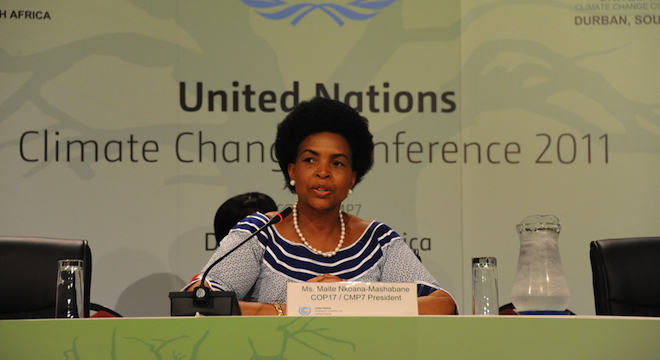EMILY GERTZ
It’s not a stretch to say that expectations going into, even during, the 17th annual U.N. climate talks in Durban, South Africa, were at an all-time low. When U.N. Secretary General Ban Ki-Moon can’t even muster a happy face, you know things are really bad.
That’s why it was so surprising that any deal whatsoever was hammered out from the two-week long negotiations.
But one was, deep into diplomatic overtime: After extending the conference an extra three nights and two sleepless nights, negotiators from 194 nations finally managed on Sunday morning to squeak out a bare-bones framework on how to deal with global climate change going forward.
The “Durban Platform for Enhanced Action” calls for participating nations “to launch a process to develop a protocol, another legal instrument or an agreed outcome with legal force,” to replace the 1997 Kyoto Protocol, the last, strongest emissions-cutting agreement to be reached from a U.N. climate summit.
“You were prepared to show the required political will to move this process forward,” said South Africa’s Minister of International Relations and Cooperation Maite Nkoana-Mashabane, president of the summit, SouthAfrica.info reported. “It is without any doubt in my mind that we have worked together to save tomorrow, today.”
Durban negotiators agreed to extend Kyoto five to seven years beyond its 2012 expiration date, despite the fact that three signatories — Canada, Russia and Japan — have said they will not join the extension. (The United States has memorably never signed the Kyoto Protocol.)
The new Durban Platform, by contrast, calls for a new treaty to be presented no later than 2015 and enacted no later than 2020. As Politico’s headline wryly summarized the achievement: “Durban climate conference ends with deal for more deal-making.”
And as the Washington Post observed, there’s a lot of detail missing from the new agreeement, particularly the precise amount that nations will cut carbon, and over what time period.
Still, the Durban Platform is perhaps most noteworthy for the inclusion of one word: “all,” — that is, any new agreement will apply to all 194 nations, from legacy industrialized nations including the U.S., Canada, Germany, and Japan to growing emitters like India and China. Under the Kyoto Protocol, China and India were lumped with rest of the developing countries and exempt from making drastic carbon-emissions cuts.
Removing this wall has long been a demand of the U.S., which has been heavily criticized for years for obstructing progress on a climate treaty.
“Bringing developing countries into the system is important because Kyoto regulates only a third of greenhouse gas emissions, and China and India have become two of the world’s three biggest polluters since the pact was agreed in 1997,” Bloomberg News pointed out.
As harrowing as Durban’s final hours may have been, the real work is only beginning, of course.
“Governments face four grueling years of horse-trading over how far and how fast each country should cut its carbon, in order to flesh out the bones of the deal,” the Guardian reported, citing UK energy and climate secretary Chris Huhne.
The talks also closed with an agreement on the design of the Green Climate Fund, intended to channel $100 billion dollars-a-year from the wealthy nations to the developing world by 2020, to help developing countries adapt to global warming and establish low-carbon energy and industry. Developing nations got their way on that one, as the Fund will be managed by the UN rather than an outside entity, such as the World Bank, which the United States and other developed countries preferred.
But as SciDev reported:
“The final document does not clarify where the money will come from or how much cash, if any, is already there, which country will host the fund, or who the trustees will be. Neither does it clarify its links with two other key committees – the adaptation committee to oversee adaptation activities in developing countries; and the technology executive committee to oversee technology development and transfer.”
The U.S. position is that donor countries should decide for themselves how to amass the money, rather than being tasked with precise, all-encompassing directives. Developing nations fear that such a loosey-goosey structure would let developed nations shrug off their multi-billion dollar committments.
One idea proposed at Durban would place a fee on the carbon emissions created by ocean-going cargo vessels, which are around 3 percent and rising of the world’s human-propelled greenhouse gas pollution.
“Oxfam estimates that a fee of $25 per ton of carbon would generate $10 billion a year,” Mother Jones reported.
But, according to Reuters, that proposal faced too much opposition at Durban, and was scrapped.
An aviation tax is another option. The “Least Developed Countries” (LDCs) bloc at Durban has suggested levying a fee on ticket-buyers on all international flights, under the theory that if you have the money to fly internationally, you can afford to pay for your carbon pollution too.
But the European Union and U.S. are already at odds on such fees. When the E.U. recently established a carbon tax on flights through member nations, the House of Representatives passed a bill forbidding American airliners from paying the surcharge.
Still, at this point, any forward progress on fighting climate change is welcome. Here’s looking forward to the 18th annual U.N. climate summit in Qatar, where hopefully the heat will be constant reminder of what needs to be done.









